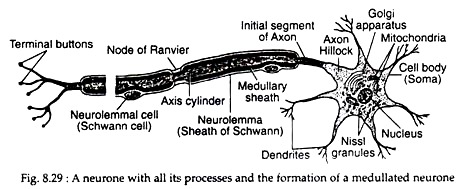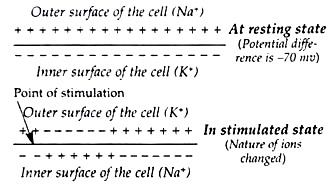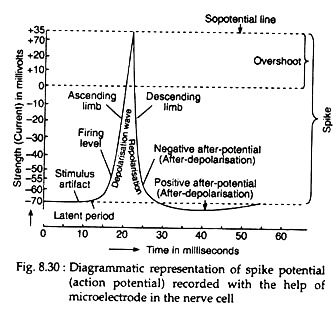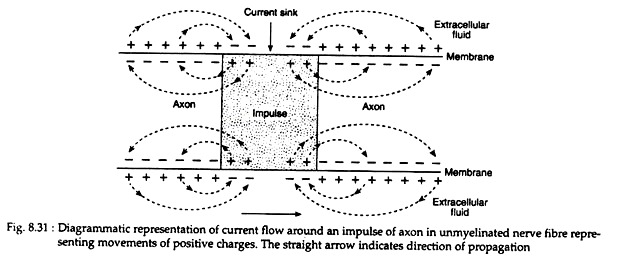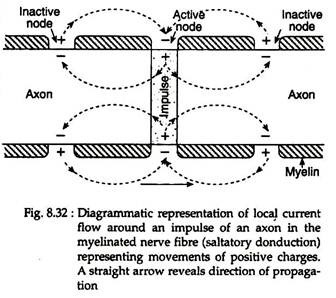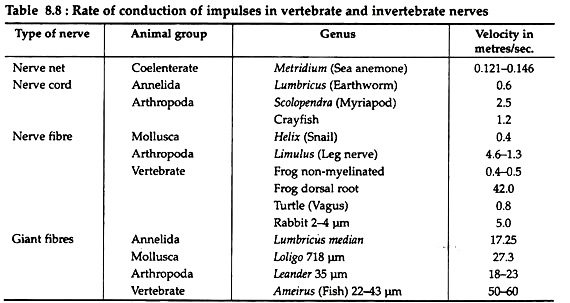In this article we will discuss about:- 1. Definition of Nerve Impulse 2. Propagation of Nerve Impulse 3. Rate of Conduction.
Definition of Nerve Impulse:
The electrochemical wave that travels along nerve fibre and stimulates muscles, glands or other nerve cells is called nerve impulse.
Typical structure of neuron:
Neuron is the structural and functional unit of nervous system. It consists of a nerve cell body or soma and two types of processes-axon and dendrite (Fig. 8.29).
Soma:
It is an irregular-shaped structure in the centre of which there lies a spherical nucleus with prominent nucleolus and Nissl granules. It also contains mitochondria, Golgi body, ribosome and ER etc.
Dendrite:
It is the process of the cell body that carries impulse towards the cell body. It is usually short with many branches and contains Nissl granules.
ADVERTISEMENTS:
Axon:
It is the process of a nerve cell body that carries impulse away from it. It is usually single, long slender process and sometimes branched and contains axoplasm, neuro-fibril, etc. It terminates into branches with terminal buttons.
Classification of stimulus:
(a) Subliminal stimulus:
ADVERTISEMENTS:
Which can produce the local excitatory state (LES) only?
(b) Threshold value of stimulus:
Which can produce or transform the LES to action potential?
Propagation of Nerve Impulse:
The propagation of nerve impulse involves two major parts – A. Origin/stimulation of nerve impulse, B. Propagation/ travelling of nerve impulse.
A. Origin of Nerve impulse:
In resting nerve cells, the surface is positively charged and the interior is negatively charged. When the surface is stimulated the stimulated point becomes negative. The fluids both inside and outside the cell are electrolytic solution containing 150-160m Eq/litre.
Positive ions and negative ions are accumulated along the outer and inner surface of the cell membrane, respectively. This is achieved by Na+ outside and K+ inside the cell membrane, and because Na+ is placed above the K+ in the electrochemical series.
Development of local excitatory state and Development of action potential:
ADVERTISEMENTS:
When stimulation is applied on the nerve cell, external Na+ rushes inside the cell making the inner surface positively charged. The amount of Na+ is not sufficient to generate action potential and returns to the outside immediately, causing a closed circuit.
Resting potential:
In resting state the nerve fibres remain in polarised state and the membrane potential lies within -70 mv. Na+ concentration outside the membrane is higher than that of inside and K+ concentration inside the membrane is higher than that of outside. K+ can permeate through the membrane at resting condition but the Na+ cannot permeate.
State of De-polarisation:
Permeability of Na+ to membrane is increased only after stimulation; causing de-polarisation. The tremendous increase in Na+ conductance during this period is known as activation of membrane. After an initial slow rise, de-polarisation wave overshoots rapidly and can reach the iso-potential line (above zero line) to approximately +35 mv (Fig. 8.30).
State of re-polarisation:
After reaching the iso-potential line K+ begins to come out from inside the membrane, causing outside to be positive again. This is called re-polarisation.
Spike potential:
The periodic rise of de-polarisation wave and rapid fall of re-polarisation wave are known as spike potential.
Negative after potential:
At approximately 2/3rd of the polarisation, the rate of fall is being abruptly slowed down. This slower fall is known as negative after potential.
Positive after potential:
With the disappearance of the negative after potential, although the rising membrane potential is achieved, yet the resting ionic status is not established. It is achieved by the active Na+ pump mechanism, which causes the positive after potential. At the same time K+ travels back to the inside of the membrane.
B. Propagation/travelling of nerve impulse:
1. Propagation on non-medulated nerve fibre:
According to the membrane theory, nerve impulse is a propagated wave of de-polarisation.
i) When the fibre is excited at a point, the polarity is reversed. This reversed polarity is due to increased permeability of Na+ to the membrane, which develops de-polarisation wave.
ii) A local circuit current flows between the de-polarised membrane and the resting membrane areas.
iii) Positive current flows inward through the de-polarised membrane and outward through the resting membrane and in this way circuit is completed.
iv) The local de-polarisation current then exits the adjacent portion of the membrane progressively more and more de-polarisation.
v) The de-polarisation wave travels in all direction along the entire length of the nerve fibre.
2. Propagation in myelinated nerve fibre: Salutatory conduction:
In the myelinated nerve fibre conduction depends upon the similar pattern of circular current flow. Myelin sheath is an effective insulator. Ions cannot pass along the myelin sheaths but nodes of Ranvier permeate ions through it more easily. For this reason the impulse is transmitted from node to node rather than continuously along the entire of the nerve fibre (Fig. 8.32).
The de-polarisation in myelinated action jumps from one node of Ranvier to the next. This jumping or leaping of de-polarisation from node to node is known as saltatory conduction.
Rate of Conduction of Nerve Impulse:
The basic principle of origin and propagation of nerve impulse is same, both in non-medulated and myelinated nerve fibres but the saltatory mechanism of conduction in myelinated nerve fibre increases the velocity of conduction more than 500 times.
The rate of conduction of a nerve impulse increases with an increase in the cross sectional diameter of the neuron and with increasing thickness of the myelin sheath. The rate of transmission for a given neuron is a constant. Table 8.8 gives an idea about rate of nerve impulse conduction through different nerves of various animals.
